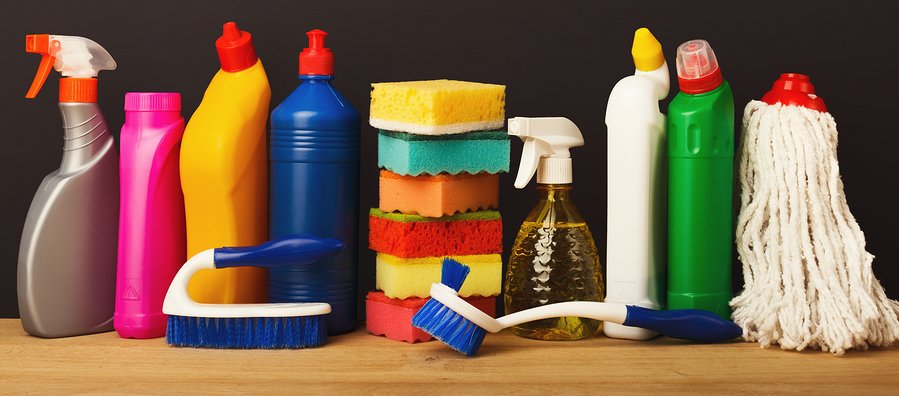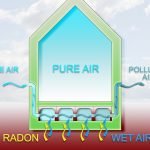Cleanliness is next to godliness, or so many of us grew up thinking. Obviously, keeping a clean home is important, but it may not be as good for you as you might imagine. According to new research, that can be especially true if you are the one in charge of scrubbing down those counters, toilets, and such with harsh chemicals. In fact, the findings suggest that doing home cleaning frequently can potentially be detrimental to your health.
The study, which was conducted at the University of Bergen in Norway, found that women who have regular exposure to cleaning products may experience a swifter decline in lung function as they age.1 Svanes, Oistein; et al. “Clean at Home and at Work in Relation to Lung Function Decline and Airway Obstruction.” American Journal of Respiratory and Critical Care Medicine. 16 February 2018. Accessed 11 March 2018. http://www.atsjournals.org/doi/abs/10.1164/rccm.201706-1311OC. And this, likely, would hold equally true for men, however not enough of the men in the study were the primary cleaners of their homes to know for sure.
This investigation included 6,230 adults who participated in the European Community Respiratory Health Survey. The subjects were spread throughout nine western European nations. Each visited one of 22 health centers where they received lung function tests and answered questionnaires at three points over a 20-year period.
When the research began, the volunteers had an average age in their mid-30s, and they were roughly evenly split between men and women. A difference appeared when survey questions pertaining to doing the cleaning at home showed that 85 percent of the women reported primarily handling this responsibility. What’s more, 8.9 percent of the women defined their occupation as cleaning-related, whereas only 1.9 percent of the men held such a job.
For each of the three lung function assessments, two separate testing methods were employed. The first of these was forced expiratory volume, which measures the amount of air an individual can forcibly exhale in one second. The second test was forced vital capacity, which evaluates how much someone can forcibly exhale after taking the deepest breath possible.
Lung function begins to decline in all of us around the age of 35, and over time, respiratory muscle strength and lung volume both decrease. As with all age-related changes, this decline varies to some extent from person to person, but the study’s results showed clearly that regular use of cleaning products is associated with a more rapid deterioration. The slowest declines in lung function in women were among those women who did little to no cleaning at home. Women who said they used cleaning products at least once a week were found to have an accelerated rate of lung function decline. And among those women whose occupation included cleaning, and therefore presumably cleaned several days a week, the lung function decline was the most rapid.
The difference was considerable, with women who cleaned for a living having only slightly less decline in lung function than what is typically seen in people with a 20-year daily smoking habit of a pack a day. No such link was discovered among men, but, as mentioned earlier, that is probably because just a small percentage of them performed any regular cleaning duties at home, and fewer still were employed as cleaners.
Surprisingly, the study found no ties between cleaning products and elevated risks for asthma, emphysema, or other chronic airway conditions. But other research has turned up a link between exposure to some of the chemicals in cleaning products and diseases. In fact, a 2017 study at the French Institute of Health and Medical Research in Paris showed using disinfectants to clean surfaces at least once a week may increase the risk of developing chronic obstructive pulmonary disease by as much as 32 percent.2 Dumas, Orianne; et al. “Nurses’ regular use of disinfectants is associated with developing COPD.” EurekAlert. 10 September 2017. Accessed 12 March 2018. http://www.eurekalert.org/pub_releases/2017-09/elf-nru090817.php.
While the current study was not designed to prove cause and effect, it certainly outlines a clear association between cleaning product exposure and lung function issues. But what does that mean for us? Obviously, it’s not a free pass to never clean your home again. It does, however, serve as a good reminder that what we bring into our environment can greatly affect our health.
So, consider using just a dampened cloth to wipe down surfaces if possible. When true cleaning products are necessary, try to avoid some of the strongest chemicals such as chlorine bleach and triclosan. Instead, opt for those products that contain ecologically friendly cleaners in brands like Mrs. Meyer’s and Seventh Generation. Or, you might want to consider using a carbon filter, respirator mask whenever you clean. They’re not very expensive, and although they may look funny, they will block most of the dangerous chemicals involved in cleaning products—and perhaps save your lungs.
References
| ↑1 | Svanes, Oistein; et al. “Clean at Home and at Work in Relation to Lung Function Decline and Airway Obstruction.” American Journal of Respiratory and Critical Care Medicine. 16 February 2018. Accessed 11 March 2018. http://www.atsjournals.org/doi/abs/10.1164/rccm.201706-1311OC. |
|---|---|
| ↑2 | Dumas, Orianne; et al. “Nurses’ regular use of disinfectants is associated with developing COPD.” EurekAlert. 10 September 2017. Accessed 12 March 2018. http://www.eurekalert.org/pub_releases/2017-09/elf-nru090817.php. |












The average household is a
The average household is a danger zone for families—especially those with kids—as there are several toxic cleaning products easily within reach. Many of these products are those we use every day, for instance; dishwash cleaner, toilet cleaner, and multi-surface cleaner amongst other products. Most of these products are toxic, with manufacturers claiming that if used as directed, these products are safe. This leads to a false sense of safety and security.